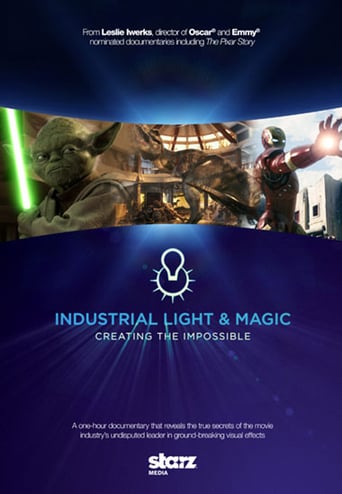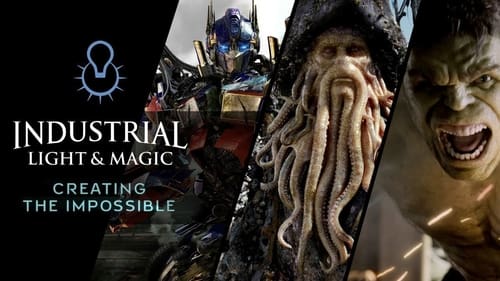




An Exercise In Nonsense
Blending excellent reporting and strong storytelling, this is a disturbing film truly stranger than fiction
View MoreExactly the movie you think it is, but not the movie you want it to be.
View MoreA film of deceptively outspoken contemporary relevance, this is cinema at its most alert, alarming and alive.
View MoreScore: 2/5 What earned the film this score: Overall it doesn't provide the informative look at this company and the VFX industry what one would expect from a documentary, focusing on what ILM accomplished over how it was achieved. Yet a few interesting facts are scattered over its run time.Comments: Lack of the most important details: This film is a propaganda piece focused on how ILM is the shining front runner of the VFX industry. It shows off their achievements in a chronological order, but barely gets into the technical details of the work they do. Any time they explain how one job or another was a major technical challenge at the time the best they do for the viewer is breeze through the names of the technologies they developed to accomplish the task without explaining what specifically the difficulty was or how they overcame it.A constant stream of praise: On the other hand they take a great deal of time just stating how amazing one accomplishment or the other was, describing the awesomeness of ILM in great verbal detail. If the filmmakers cut the instances of Tom Cruise just exclaiming how this or that was revolutionary or seemed impossible at the time they would have time left for actual information about computer graphics.
View MoreIndustrial Light & Magic (ILM) is a special effects company started by George Lucas in the mid-1970's. The SFX created by ILM are still the industry standard, although, through their innovations, many other companies can now do much of the same work. Industrial Light & Magic: Creating the Impossible gives a brief overview of the accomplishments of ILM, and, through interviews with many of the key players, the history of how it all came about.I was 18 when Star Wars came out in 1977, and like many of the people my age, was just blown away by the film. While similar stories had been told in films for decades before, Lucas showed it in a way never SEEN before. We had no idea how he did it, but we knew we loved it. And the work done by the ILM team began its ascension. Interview clips with Lucas, Spielberg, Ron Howard, and other major players are included, along with many movie clips showing the feats they have accomplished.As a bit of a movie nerd, I knew the names of many of the people doing the tough work in the background at ILM, but to see their faces and hear them explain it a bit was very nice. At just over 50 minutes, minus credits, I guess my only complaint is that it wasn't twice as long. The story just seemed so large for the running time.Highly recommended for anyone curious about ILM and how it came to be.
View MoreFor anyone looking for detail of how ILM achieved each technical breakthrough, recognize that this one hour documentary had to articulate multiple achievements gleaned from over 300 movies. These editors put together a masterful and seamless chronology of breakthroughs given the limitations of time to explain the evolution of CGI. Although some may argue that the earlier Star Wars episodes were more "real" because they used stop motion and models, the documentary was not about aesthetic interpretation. It was about breakthroughs that have not only revolutionized movies but medical imaging as well. Like Pixar Story, this documentary is about imagination and achievement, not an inside critique of industry politics or aesthetic limitations. How refreshing.
View MoreSome of the biggest names in Hollywood are interviewed for this "documentary", along with some of the world's most talented special effects people. What these people do for a living is literary creating the impossible! The director of this film had access to behind-the-scenes shots of almost every big special effects movie to come out the last 30 years, every one of which could be (and has become) a fantastic documentary about special effects on its own. The ingenious solutions these people come up with, are better than the best of magic tricks. And I will never get tired of learning how this magic is done, or how these people make a living.But all that is barely mentioned in Industrial Light & Magic: Creating the Impossible.Instead we get about an hour of people sitting around talking about how great they are. The ILM people love George Lucas, Lucas loves the ILM people, Spielberg loves Lucas and ILM, ILM and Lucas loves Spielberg, and so on and so on. The only good parts are when Robin Williams adds a bit of humor to all the talk, even though his anecdotes have little or nothing to do with ILM.All of them talk about one breakthrough after the other, scientific progress, artistic freedom and "the CGI renaissance" of the industry. But we barely get to know what any of these breakthroughs actually were. Just when you think they're going to explain some of the nitty gritty details about how some of these effects were achieved, what were their problems, why, and how did they solve them, the film is cut to another person talking about how great the last person was for coming up with a solution. We never get to know what any of these solutions were. They never explain the techniques which goes into creating any of the effects they talk about, other than extremely superficial stuff like: "More than 10.000 moving parts were in this shot..", "This was difficult because of the camera movement..." or "This had never been done before." But how did the manage to animate more than 10.000 moving parts? How do they track the camera movements? How did they manage to do something that had never been done before? This film certainly doesn't tell you.Also, there's never any mention of the substantial lowering of quality that we've had to endure in big special effects movies, since the dawn of CGI. Yet it's common knowledge that sci-fi, action and horror movies have taken a big step down from the greatness that was achieved in the 70, 80 and 90s. "Directors are allowed absolute freedom now" they all say, but nobody asks if that is actually a good thing. Good screen writing, captivating characters and creative solutions to limited resources have taken a back seat to big explosions and impossible movements through fake landscapes. This is never more obvious than when comparing Lucas's original Star Wars trilogy to his newer crapfest. When one animator in Creating the Impossible barely mentioned that the character Jar-Jar Binks might not be very well liked, I got my hopes up... This would be interesting, I thought. How will he justify such an atrocity put to life on screen? Instead of going any further with it, he just continues to talk about how great it was that they made him look real (even though they didn't).Because even as good as CGI have gotten today, there's nobody in Creating the Impossible who shouts out "IT DOESN'T LOOK REAL!" (like we did when we saw this "docu") And why doesn't it look real? Because we know it's generated on a computer. And as any illusionist will tell you: Creating a good illusion is not so much about doing fancy stuff with your hands, as it is about tricking the minds of the audience into making them believe what they're seeing is real. This is why models, miniatures and stop-motion animation will ALWAYS look better than CGI. Because it really is real. There's actually something there.Ironically enough, there's nothing there in this bottom of the barrel circle-jerk, but I guess that's not too surprising, coming from the same people who made equally nonsensical "The Pixar Story."
View More